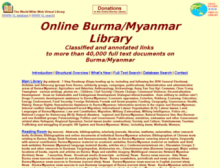Resource information
EXECUTIVE SUMMARY: "While the existing data available on landmine victims
indicate that Burma/Myanmar1 faces one of the most
severe landmine problems in the world today, little is
known about the actual extent of the problem, the
impact on affected populations, communities’ mine
action needs and how different actors can become
more involved in mine action.
The Government of Burma/Myanmar has prohibited
almost all forms of mine action with the exception of
a limited amount of prosthetic assistance to people
with amputated limbs through general health
programmes. Some Mine Risk Education (MRE) is also
conducted in areas which are partly or fully under the
control of armed non-State actors (NSAs) as is victim
assistance and some survey work, however, without
Government authorisation.
Since starting operations in 2006, Geneva Call and
DCA Mine Action, like other local and international
actors wishing to undertake mine action, have been
struggling to identify how best to do this in the limited
humanitarian space available in Burma/Myanmar.
Lack of Government permission to start mine action
activities and difficult access to mine-affected areas
are two of the main obstacles identified by these
actors. In response to this apparent conflict between
interest and opportunity, Geneva Call and DCA Mine
Action decided to produce a report on the landmine
problem in Burma/Myanmar, which would pay
particular attention to what can be done to address
the identified needs. The report is based on research
carried out between June and September 2010.
Thirty two different stakeholders in Burma/Myanmar,
Thailand, Bangladesh and China were interviewed
in order to better understand the current, medium- and
long-term effects of the landmine problem on
affected local communities and to identify possible
mine action interventions.
The problem with anti-personnel mines in Burma/
Myanmar originates from decades of armed conflict,
which is still ongoing in some parts or the country.
Anti-personnel mines are still being used today by
the armed forces of the Government of Burma/
Myanmar (the Tatmadaw), by various non-State actors
(NSAs), as well as by businessmen and villagers.
Ten out of Burma/Myanmar’s 14 States and Divisions are
mine contaminated. The eastern States and Divisions
bordering Thailand are particularly contaminated
with mines. Some areas bordering Bangladesh and
China are also mined, and mine accidents have
occurred there. An estimated five million people
live in townships that contain mine-contaminated
areas, and are in need of Mine Risk Education (MRE)
to reduce risky behaviour, and victim assistance for
those already injured.
With estimates of mine victim numbers still unclear
due to a lack of reliable data, the report finds that
a significant proportion of the children affected in
landmine accidents in NSA areas are child soldiers.
In Karenni/Kaya State every second child is a child
soldier; in Karen/Kayin State every fourth child is a
child soldier.
The Government’s refusal to grant permission for
mine action activities and the ongoing conflict have
left no real space for humanitarian demining in
Burma/Myanmar. However, some demining activities
are being undertaken by the Tatmadaw and by
NSAs, although it is unclear whether these activities
should be regarded as military or humanitarian
demining. Similarly, the complicated domestic
situation only leaves limited space for implementing
comprehensive surveys. Those surveys that have
been carried out by Community Based Organizations
(CBO), show significant mine contamination. However
such surveys can only be an indicator of the reality
on the ground as they are limited in geographical
scope.
At present, local CBOs and national NGOs have better
access to mined areas than the UN and international
NGOs. However, CBOs and national NGO mine action
activities are limited to MRE and victim assistance-related
activities because of the Government
restrictions placed on other forms of mine action.
These activities are only conducted on a discreet
level – MRE is provided under general Risk Reduction
or health programmes while victim assistance falls
under general disability assistance programmes.
A national ban on anti-personnel mines and a ban by
the major NSA users of landmines do not seem to be
realistic in the near future. Nevertheless, the success
of local/regional bans on anti-personnel mines,
especially in the western part of Burma/Myanmar
could serve as an inspiration and a positive harbinger
of progress for this country marred by decades of
internal strife and war.



